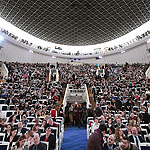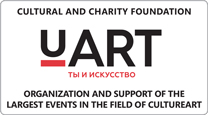23 December 2016
Pirosmani and Co.
For the first time at the
Pushkin Museum: Georgian painters of the first third of the 20th
century
Text: Olga
Muromtseva
|
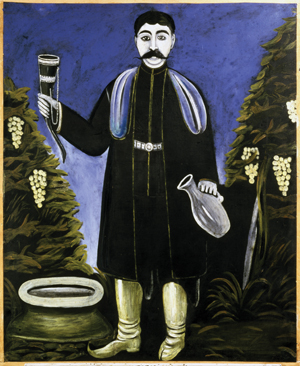
Niko Pirosmani (Niko
Pirosmanashvili).
Prince with a Horn of Wine. 1909
|
This fall-winter exhibition
season in Moscow museums has seen a grand assortment of vibrant art events.
Long queues cannot frighten art lovers keen to view the masterpieces of the
Vatican collection or visiting displays from French and Italian museums. Going
to an art show has become a fashionable trend, and its followers closely
monitor museum programs for updates, booking tickets in advance. The U-ART
fund, jointly with the Pushkin State Museum of Fine Arts, has created a project
that in the list of the winter 2016/17 exhibitions is worthy of a prominent
spot — thanks to the concept behind it.
The exhibition «Georgian avant-garde of
1900−1930s: Pirosmani, Gudiashvili, Kakabadze, and others. From museums and
private collections» is open to the public from 8 December 2016 to 12 March
2017.
For the first time in the modern Russian
history, works of the most prominent Georgian avant-garde artists of the first
third of the 20th century have been brought together at one exhibition. The
three floors of the Private Collections Department of the Pushkin Museum host
the display of paintings and drawings by Niko Pirosmani, Lado Gudiashvili,
David Kakabadze, Kirill (Cyril) Zdanevich, Petre Otskheli, Zygmunt (Zygi)
Waliszewski, Irakli Gamrekeli, and others. The exhibition also includes the
artists' lifetime prints, cinema posters, theatrical costumes, archive items,
and movies.
Major Russian museums, including the
Tretyakov Gallery, the Russian Museum, the State Museum of Oriental Art, the
Bakhrushin Central Theater Museum, as well as private collectors from Russia
and Georgia, have been invited to participate in the event. By gathering
artwork from multiple museums and private sources, the curators Iveta
Manasherova and Elena Kamenskaya have managed to create a one-of-a-kind display
featuring more than 20 pieces by Niko Pirosmani (Pirosmanashvili), each
boasting an impeccable provenance and fascinating history.
A million legends and the truth of
art
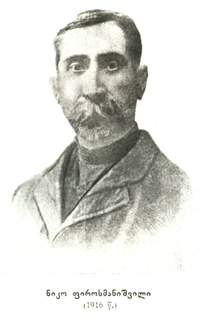 |
|
Niko Pirosmanashvili.
Photograph. 1916
|
In 1912 Mikhail Le Dentu and Ilya Zdanevich
during a trip to Georgia discovered a self-taught painter named Niko Pirosmani,
whose art was in tune with the most daring artistic ideas of the era and
reminiscent of Henri Rousseau's primitivism. For Georgian artists of the «new»
generation, Pirosmani's paintings were an example of pure art free of academic
staleness. Pirosmani's works, for the first time displayed in Russia in 1913 at
the Mishen' exhibition, made a huge impression on Russian avant-garde artists.
Pirosmani's influence can be felt in Mikhail Larionov's and Natalia
Goncharova's primitivist paintings.
In Russia, Pirosmani's works enjoy
affectionate appreciation; tales associated with his life and art are
well-known. The poor artist's romantic attraction to actress Margarita has
become part of the Pirosmani mythos and made the plot of the popular song
«Million red roses.» To this day, most stories about the artist's life have no
hard documentary evidence. «Niko Pirosmani has so completely dissolved in the
common folk that it is difficult for our generation to discern the facts of his
personal life. His everyday life was so mysterious that, perhaps, he will have
to remain without a conventional biography…» Written in 1926, these words
still make sense today.
The exhibition «Georgian avant-garde …»
provides a rare opportunity to see all Niko Pirosmani's masterpieces in one
place: his famous feast scenes («Family Company», TG, «Tiflis Shopkeepers
Dining with Phonograph,» Shalva Breus' collection, Moscow), animal figures
(«Roe Deer», Valentin Schuster's collection, St. Petersburg, «Tatar — Camel
Driver», Igor Sanovich's collection, Moscow), human portraits («Portrait of
Ilya Zdanevich», Valentin Schuster's collection, St. Petersburg, «Prince with a
Horn of Wine», RM), and historical paintings («Naval battle. Russo-Japanese
War»). These powerful works carry the viewer into the world created by the
artist, depicting the real and imaginary life of the early 20th century
Georgian towns and villages, folk traditions, characters, architecture, ways of
living, and national culture.
Georgian modernists in
Paris
For two of the other artists whose paintings are featured at
the exhibition - Lado Gudiashvili and David Kakabadze — Pirosmani's work
was an object of unflagging interest. Gudiashvili met Pirosmani in 1915, and
this encounter undoubtedly had an impact on the younger artist. Not unlike
Pirosmani's, his works also relate the atmosphere of Georgian life, its rhythm
and flavor. However, Gudiashvili's style, formed by the culture of his native
land as well as by Persian miniatures and later refined during his five-year
stay in Paris, is distinctly elegant and sophisticated. In Paris Gudiashvili
quickly plunged into the maelstrom of artistic life, meeting and befriending
the likes of Amedeo Modigliani, Pablo Picasso, Fernand Leger, and other artists
of the circle known today as the Paris School. Gudiashvili's art displayed at
the Salon d'Automne enjoyed success, which brought him more friends as well as
lovers of his talent, happy to acquire his paintings.
|
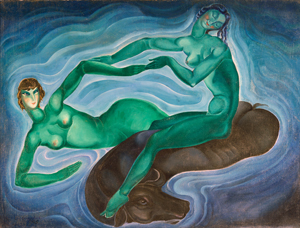
Lado Gudiashvili. Green
fairies. 1925
|
As the Paris period is considered the most remarkable and
original in Gudiashvili's oeuvre, it is no wonder most works presented at the
exhibition in the Pushkin belong to this time in his career. This is how the
famous art critic Maurice Raynal, the author of the first monograph on Lado
Gudiashvili published in 1925 in Paris, describes his work: «Being embodied in
the exclusively national spirit, it [the art] presents to us the scenes of
everyday Georgian life. Women and warriors with strikingly shaped eyes — true
children of a nation lively, belligerent, drunk with their outdoors lifestyle,
mountainous expanses, fast horseback riding, and all sorts of adventures. Here
they are fighting, here having a riotous feast, here they are dancing, here
seeking comfort in love, and almost all of it, so to speak, — on horseback, for
the horse in the life of a Georgian plays the most significant role.»
Gudiashvili's paintings are truly poetic and full of
symbols. Themes and characters depicted by the artist reflect his singular
talent and the unending homesickness that haunted him even in the happiest and
most successful Parisian years. In 1925 Gudiashvili decided to return to
Georgia, despite the diverse perspectives the art world of Paris opened
to him.
Innovations of David
Kakabadze
|
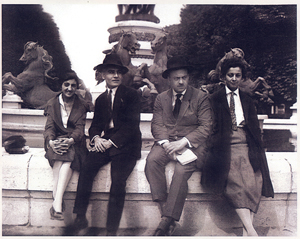
Georgian artists in Paris. Left to
right:
T. Piralishvili, L. Gudiashvili, D. Kakabadze, E. Akhvlediani.
1925
|
Like his friends Lado Gudiashvili and Shalva Kikodze, David
Kakabadze received a grant from the Georgian Artist Society and, together with
Gudiashvili, arrived in Paris on January 1, 1920. Both artists instantly fell
in love with the city and often roamed the squares and streets of Paris, making
pencil sketches, but their styles were decidedly different. Lado's thin, broken
lines starkly contrasted with David's vibrant strokes. Both drew inspiration
from Georgia, but Kakabadze's works testify to the fact that he was fascinated
with his homeland's nature first and foremost. He was also enthralled by the
architecture of ancient Georgian churches, especially the complex stone relief
patterns decorating their walls. Kakabadze studied these ornaments specifically
and even wrote an entire paper on the subject complete with his sketches.
Except for a few early items done in the realist manner, the
exhibition presents mainly abstract works by David Kakabadze, created during
his Paris period. The artist's transition to abstraction can be observed in the
watercolor set entitled «Brittany». It was this north-western province of
France, visited by Kakabadze in 1921, where he created first realist, then
cubist, and finally biomorphic images of Breton houses and boats on water.
David Kakabadze was an experimental artist and researcher.
Having studied engineering at the Natural Sciences Department of St. Petersburg
University), he loved to tinker with mechanical devices. In 1922, he created a
stereo movie projector that enabled the audience to see three-dimensional
images without glasses. Kakabadze patented this invention in many countries —
France, USA, Great Britain, Germany, Denmark, Spain, Belgium, Italy, Hungary,
and others — and a stock company was founded to fund the construction of a
working prototype. Kakabadze was able to build the prototype and get first 3D
images, but subsequent lack of funds prevented him from working further on the
invention. Later, drawing on this experience, the artist created his collages
or, as they were named afterward, constructive-decorative compositions, which
may be considered his special legacy in visual arts. The materials he used were
wood, metal parts, lenses, mirrors, and other items left over from his
inventions. The images created in this manner were closer to organic, embryonic
shapes. Kakabadze was one of the first to use spray paint for coloring the
background. He also devised special frames, wooden and metal, adorned with
various spare parts, to be integral components of the compositions.
|
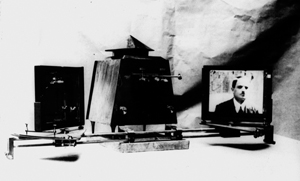
David Kakabadze (left) and Shalva Kikodze
in Paris.1924
|
The art of David Kakabadze is not as well-known to the
Russian public as it deserves. Most of his works presented at the exhibition
come from private collections. Kakabadze's only work from the Tretyakov Gallery
collection was donated to George Costakis Museum. It is noteworthy that
avant-garde collectors have always valued Kakabadze's works highly. The US
artist, collector, and art critic Katherine Dreier, who has done much to
popularize avant-garde art in the United States, acquired an abstract sculpture
by Kakabadze and several of his watercolors in the mid-1920s. Thus the
Georgian's art appeared at the Brooklyn International Exhibition in New York in
1926 and later ended up in the collection of the Yale University Art Gallery,
to which Dreier donated a treasure trove of modern art.
Upon their return to the homeland, the lives
of David Kakabadze and Lado Gudiashvili followed different paths. However, both
artists had worked in theater and cinema. Together they acted as production
designers of a black-and-white silent film «Saba». Gudiashvili also
participated in the production of the films «Khabarda», «Doomed», «The
Divorce», and others. The undoubted masterpiece of David Kakabadze as a film
art director was the documentary «Salt of Svaneti.» Fragments of these and
other Georgian motion pictures of 1920−30s are shown at the
exhibition.
Theater
|

Brothers
Kirill and Ilya Zdanevich hold the honor of discovering the work of Niko
Pirosmani to the artistic
community
 |
A special part of the exhibition displays theatrical works
of Georgian artists. The transformation that Georgian theater underwent after
the Russian Revolution was accomplished owing mostly to the efforts of
directors Kote Marjanishvili (1872−1933) and Sandro Akhmeteli (1886−1937). The
experienced Marjanishvili, having taken the helm at the Tbilisi Shota Rustaveli
Theater, found gifted young artists Irakli Gamrekeli and Petre Otskheli, whose
early 1920s works constituted a breakthrough comparable to the one the
constructivists made in the Russian theater. The production of Vladimir
Mayakovsky's «Mystery-Bouffe», in the end abandoned, became the first
experiment, and the visual arts part was entrusted to Gamrekeli.
|
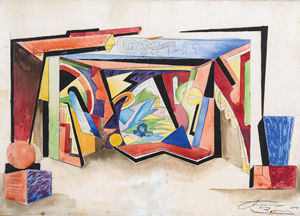
Kirill Zdanevich. Suprematist set
design. 1925
|
Theatrical drawings by P. Otskheli, I. Gamrekeli, and K.
Zdanevich — bright, unusual, futuristic — introduce the exhibition visitors to
the creative atmosphere of Tiflis of the 1920−30s, with its indispensable
ingredient — the famous artistic cafés «Himerioni», «The Argonauts' Ship», and
«Peacock's Tail». The walls of these remarkable establishments were painted by
the likes of Gudiashvili, Kakabadze, Sudeikin, and Toidze. They were frequented
by Georgian poets, writers, artists, and philosophers, as well as their Russian
counterparts who fled from the famine and revolutionary turmoil to the warm and
welcoming Tiflis (capital of Georgia, Tbilisi after 1936). Within their walls
were born the poems and plays later published by the famous group 41 Degrees
founded by Terentyev, Kruchenykh, and Ilya Zdanevich. Some of these
publications are also displayed at the exhibition, complementing the diverse
and vibrant panorama of the artistic life in Tiflis during the first third of
the 20th century.
In total, the exhibition «Georgian Avant-garde» features
more than 200 paintings and drawings as well as a printed publication, which
includes a series of scholarly articles written by an international team of
authors, the catalog, and the art album section. Illustrations and catalog
materials have been provided in part by museums of Georgia, which responded
enthusiastically to the organizers' inquiry. The exhibition of Georgian
avant-garde in the Pushkin Museum is an international project that aims to
emphasize the importance of dialogue between the two countries the histories
and cultures of which have been inextricably linked for many centuries.

Niko Pirosmani (Pirosmanashvili). Family Feast. 1906
|
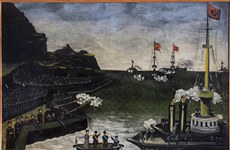
Niko Pirosmani (Pirosmanashvili). Niko Pirosmani (Pirosmanashvili). Naval battle. Russo-Japanese War. 1906
|

Niko Pirosmani (Pirosmanashvili). Sister and brother (according to the play by V. Gunia)
|

Lado Gudiashvili. Horses. 1921
|
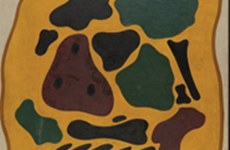
David Kakabadze. Abstract composition. 1921
|
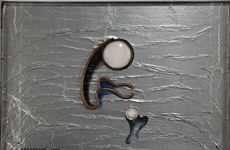
David Kakabadze. Constructive-decorative composition. 1925
|

Lado Gudiashvili. After the feast. 1922
|
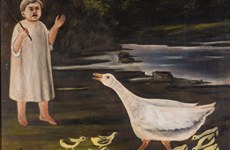
The girl and the goose with goslings. 1917
|
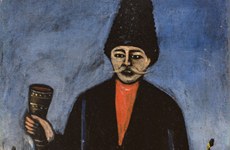
Karachoheli (noble) with a horn of wine
|
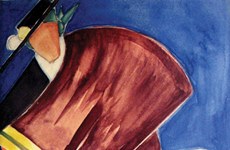
Kirill Zdanevich. Sketch of a Spanish costume. 1910
|
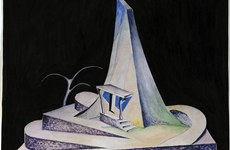
Irakli Gamrekeli. Sketch of a set design for the play "Lamara". 1930
|

Irakli Gamrekeli. Set design sketch for the play "Mystery-Bouffe". 1924
|
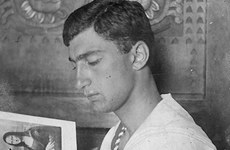
Ilya Zdanevich
|
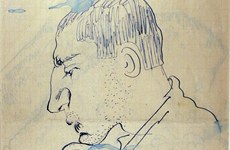
Portrait of Kirill Zdanevich by Zygmunt Waliszewski
|

David Kakabadze (left) and Shalva Kikodze in Paris. 1920
|
26 December 2016
Russian media did not ignore the international cello festival — virtually every concert of the program provoked the interest of journalists, and the artistic director and guests of the festival became the heroes of many publications. Let's summarize the reviews.
8 December 2016
A private view of Georgian art at the Pushkin Museum. The entire business and cultural elite of Moscow gathered that evening at the Private Collections Department of the Pushkin Museum, the three floors of which were milling with notable guests.
7 December 2016
At the Vivacello festival, the Italian cellist and composer performed his Antidotum Tarantulae XXI concert for the first time in Russia. This “modern antidote for tarantula bite” stirred, probably, most discussions in the press and among the festival visitors alike. The expressive modern music is in conversation with the past, with the Renaissance and Baroque — and for explanations we turned to Giovanni Sollima himself
29 November 2016
The 8th VIVACELLO Festival, held as usual at various Moscow venues under the management of Boris Andrianov and the culture and charity foundation U-Art: You and Art, has exposed certain important issues concerning interpretation and perception of music written for so unhurried an instrument. (Osip Mandelstam likened the density of the cello timbre to honey flowing from a tilted glass jar)
2 November 2016
Art Patrons Iveta and Tamaz Manasherov Participate in a Pompidou Center’s Project. The collection of Russian art in the P ompidou Center is well-known internationally and includes works by Kandinsky and Malevich,
Chagall and Pevzner, Puni and Exter, Bulatov and Kabakov - great names and seminal works all throughout ...
Back























